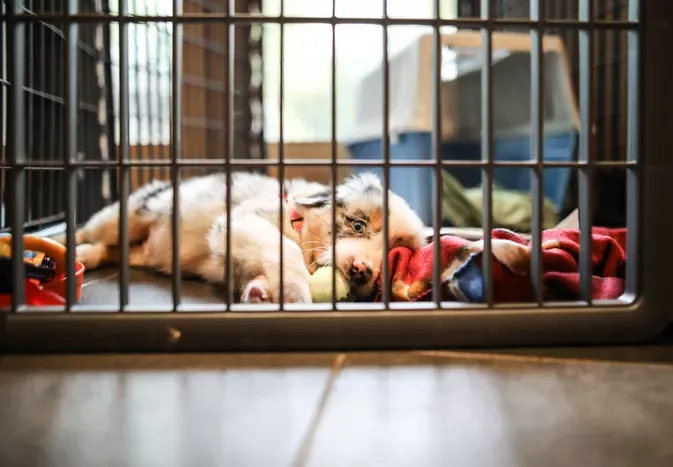How to Crate Train an Older Dog
Updated on 04/26/24

Mastering Crate Training: A Comprehensive Guide to Housebreaking Your Older Dog
Crate training is an invaluable tool for dog owners, offering numerous benefits for both the pet and the human companion. While it's often associated with puppies, even older dogs can reap the rewards of crate training.
Whether you're bringing home a rescue or an adopted dog, or simply want to improve your canine companion's behavior, this comprehensive guide will empower you with the knowledge and techniques necessary to successfully crate train your older dog.
Understanding the Benefits of Crate Training
Crate training is not about confining your dog, but rather providing them with a safe and comfortable space that they can call their own. It offers numerous advantages, including:
* Housebreaking: A crate is an excellent tool for housetraining, as dogs instinctively avoid soiling their sleeping area.
* Reduced anxiety: Crates provide a sense of security and reduce stress in dogs, especially during stressful situations like thunderstorms or fireworks.
* Improved obedience: Crate training can aid in teaching basic commands like "sit," "stay," and "come" by limiting distractions.
* Safety: A crate can keep your dog safe when you're not home, preventing them from chewing on furniture or getting into mischief.
* Travel ease: Crates are essential for safe and comfortable travel, whether it's by car, plane, or train.
Choosing the Right Crate
The first step in crate training is selecting the appropriate crate size. Your dog should be able to stand up, turn around, and lie down comfortably inside. Consider your dog's breed, weight, and height when choosing a crate.
* Measure your dog: Measure your dog's height from the top of their head to the floor, and their length from the tip of their nose to the base of their tail.
* Add 2-4 inches: Add 2-4 inches to both the height and length measurements to ensure your dog has enough space to move around.
* Consider their breed: Some breeds, like Bulldogs and Pugs, require crates with more headroom due to their flat faces.
Getting Your Dog Used to the Crate
Once you have the right crate, it's time to introduce your dog to it gradually. Follow these steps:
* Place the crate in a quiet area: Avoid placing the crate in high-traffic areas or near potential triggers like windows or doors.
* Make it cozy: Add a comfortable bed or blanket to the crate to make it inviting.
* Leave the door open: Initially, leave the crate door open so your dog can explore it at their own pace.
* Feed your dog in the crate: Start feeding your dog their meals in the crate to associate it with positive experiences.
* Play games near the crate: Engage your dog in play sessions near the crate to create positive associations.
Training Your Dog to Stay in the Crate
Once your dog is comfortable entering the crate, you can start teaching them to stay in it. Begin with short intervals:
* Close the door for a few seconds: Once your dog is inside the crate, close the door for just a few seconds and reward them with a treat.
* Gradually increase the time: As your dog becomes more comfortable, gradually increase the amount of time they stay in the crate.
* Never use the crate as punishment: The crate should always be a positive experience for your dog. Avoid using it as a punishment or time-out.
Troubleshooting Common Challenges
Crate training can be challenging at times, but understanding and addressing common obstacles can help ensure success:
* Whining or barking: If your dog whines or barks in the crate, ignore them. Giving them attention will only reinforce their behavior. Wait until they're calm and quiet before letting them out.
* Soiling the crate: If your dog soils the crate, do not punish them. Simply clean it up and try again. Make sure the crate is the appropriate size and that your dog is not being left in it for too long.
* Stress or anxiety: If your dog shows signs of stress or anxiety in the crate, seek professional help from a veterinarian or certified dog trainer.
Additional Tips for Older Dogs
Crate training older dogs may require some additional considerations:
* Start slowly: Be patient and give your dog plenty of time to adjust to the crate.
* Use high-value treats: Older dogs may be more motivated by high-value treats like peanut butter or cheese.
* Make it a positive experience: Always associate the crate with positive experiences, such as meals, treats, and playtime.
* Consider their health: Older dogs may have joint issues or other health conditions that require special accommodations in the crate. Consult with your veterinarian for advice.
Conclusion
Crate training an older dog can be a rewarding experience that benefits both the dog and the owner. By following these comprehensive guidelines, you can create a safe and comfortable space for your furry friend and enjoy the numerous advantages crate training has to offer. Remember to prioritize patience, consistency, and positive reinforcement throughout the process.
Explore More Pets

Basic Training
Puppy and Baby Introductions

Working Dog Breeds
All About Search and Rescue Dogs

Dog Treatments
Puppy Vaginitis: Signs, Causes and Treatment

Dog Adoption
After More Than 1,200 Days in the Shelter, Coco Goes Home

Basic Training
How to Train Your Puppy to Go on Potty Pads

Hybrid Dog Breeds
The Difference Between a Mutt, Mixed Breed, or Designer Dog?

Dog Treatments
Nail Problems in Dogs

Puppies
7 Reasons Why Two Dogs Are Better Than One